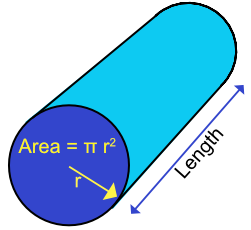A cylinder is a circular prism. As with other prisms, the volume of a cylinder can be calculated using the cross-sectional area x length.
Th cross-section of a cylinder is a circle. As the area of a circle =`πr^2`, the volume of a cylinder is `πr^2l`, where `r` is the radius of the circular end, and `l` is the length of the cylinder.

What is the volume of a cylinder with a diameter of 4cm and a length of 42cm? Give your answer correct to 1 decimal place.
| For a circle: | Area | `= pir^2` |
| Substitute | `A` | `= pi xx 2^2` |
| `= 4pi` |
The cross-sectional area is `4pi`
| For a cylinder: | Volume | = area xx length |
| Substitute | V | `= 4pi xx 42` |
| `= 527.79` |
Answer: 527.8 cm3
What is the diameter of a cylinder with a volume of 1000cm3 and a length of 100cm? Give the answer correct to 1 decimal place.
| For a Cylinder | Volume | `= pir^2l` |
| Substitute | `1000` | `= pir^2 xx 100` |
| Divide both sides by 100 | 10 | `= pir^2` |
| Divide both sides by `pi` | 3.183 | `= r^2` |
| Square root | 1.784 | `= r` |
Answer: 1.8cm